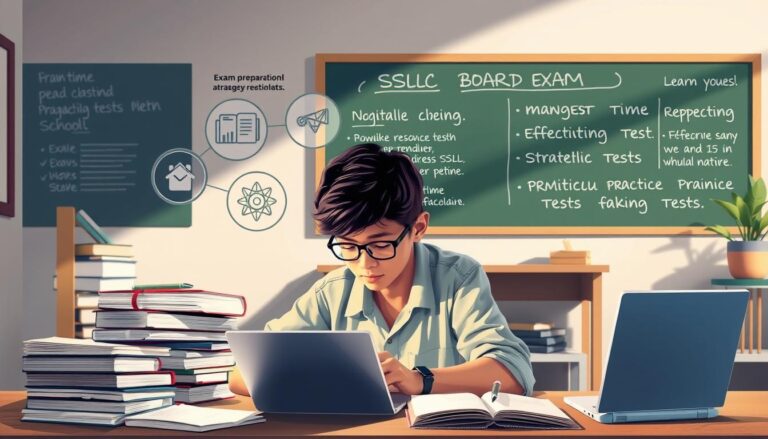Breaking Down Complex Topics in Online Learning
In today’s fast-paced online learning environment, many students feel overwhelmed by challenging material. But what if there was a way to simplify these subjects and make them more manageable? We believe it’s possible with the right approach.
Breaking down difficult concepts into smaller, digestible pieces is key. Techniques like active recall and the Feynman method can help you understand and retain information better. For example, explaining calculus basics like limits and derivatives in simple terms can build a strong foundation for advanced topics.
Our goal is to provide you with proven methods that transform overwhelming material into clear, manageable content. By using structured frameworks, you can achieve clarity and long-term retention, making learning more effective and less stressful.
Understanding the Challenge of Complex Topics
Mastering difficult subjects often feels like climbing a mountain without a map. Many learners face hurdles that make the process overwhelming. To succeed, we need to identify these challenges and find effective ways to overcome them.
Identifying Common Obstacles
One major obstacle is confusing terminologies. Words like “entropy” in physics or “derivatives” in calculus can seem abstract. Without a clear understanding, these terms create barriers to comprehension.
Another issue is cognitive overload. When too much information is presented at once, the brain struggles to process it. This often leads to frustration and a lack of progress.
Recognizing Learning Barriers
Insufficient foundational knowledge is a common barrier. For example, without a solid grasp of algebra, calculus becomes nearly impossible. Building a strong base is essential for tackling advanced concepts.
Subjects like physics and calculus often require abstract thinking. Without practical examples, these ideas remain hard to grasp. Breaking down material into smaller parts can make it more manageable.
By understanding these challenges, we can adapt our approach. Using strategies like active recall and visual aids can simplify the learning process and improve retention.
Establishing a Structured Learning Framework
A structured approach to learning can transform how we understand and retain information. By organizing our efforts, we can break down even the most challenging subjects into manageable steps. This method not only simplifies the process but also ensures long-term retention.
Developing a Topic Roadmap
Creating a topic roadmap is a powerful way to visualize your learning journey. This tool helps you map out key ideas and their relationships, making it easier to follow a logical sequence. For example, starting with basic algebra before moving to calculus ensures a smooth transition.
Using diagrams and flowcharts can further enhance this process. These visual aids allow you to see connections between concepts, fostering a deeper understanding. A clear roadmap also provides natural checkpoints to assess your progress.
Setting a Strong Foundation
Before diving into advanced material, it’s crucial to build a strong foundation. This means mastering the basics first. For instance, understanding fractions is essential before tackling more complex math problems.
Structured techniques like SQ3R (Survey, Question, Read, Recite, Review) can help reinforce this foundation. By following a systematic process, you can ensure that each step builds on the previous one. This approach not only improves comprehension but also boosts confidence.
| Method | Description | Benefits |
|---|---|---|
| SQ3R | Survey, Question, Read, Recite, Review | Improves retention and understanding |
| Topic Roadmap | Visual sequence of key ideas | Provides clarity and logical progression |
| Flowcharts | Visual representation of relationships | Enhances comprehension of connections |
For a comprehensive framework tailored to high school students, explore the Home E-Learning Academy. Their structured curriculum aligns with NCERT standards, ensuring a solid foundation for future academic success.
Implementing Complex Topic Study Strategies
Effective learning requires more than just reading and memorizing; it demands active engagement. By using proven techniques, we can enhance memory retention and simplify even the most challenging material. Let’s explore some of these methods.
Active Recall and the Feynman Technique
Active recall is a powerful way to strengthen memory. Instead of passively reviewing notes, actively retrieving information helps reinforce learning. For example, testing yourself on key concepts can improve retention significantly.
The Feynman Technique takes this a step further. By explaining ideas in simple terms, you can identify gaps in your understanding. This method encourages clarity and ensures you truly grasp the material.
Embracing Spaced Repetition Methods
Spaced repetition is another essential practice. Reviewing material at increasing intervals over time helps move information from short-term to long-term memory. Tools like flashcards are perfect for this approach.
For instance, using the Leitner System with flashcards allows you to review concepts at optimal intervals. This ensures you spend more time on challenging material and less on what you already know.
Combining these strategies creates an efficient way to review and retain information. Start by integrating active recall into your daily practice. Test yourself regularly, use flashcards, and explain concepts in simple terms. Over time, these methods will transform how you learn and remember.
Breaking Down Topics into Manageable Chunks
Breaking down information into smaller parts is a proven way to enhance learning. This approach, often called “divide and conquer,” helps prevent cognitive overload and makes even the toughest subjects easier to understand. By splitting content into segments, we can focus on one piece at a time, building a clear pathway to mastery.
Dividing Information into Segments
When we divide information into smaller segments, it becomes less overwhelming. For example, learning a new language is easier when we focus on vocabulary first, then grammar, and finally sentence structure. This method ensures that each step builds on the previous one, creating a strong foundation.
Research shows that dividing course content into manageable chunks enhances learning effectiveness. By focusing on one segment at a time, we can process information more efficiently and retain it longer. This approach also reduces stress and boosts motivation, as we achieve small wins along the way.
Sequencing for Better Retention
Sequencing study material is just as important as dividing it. A logical progression ensures that each step naturally leads to the next. For instance, understanding basic algebra before tackling calculus makes the transition smoother and more intuitive.
Using tools like mind maps or flowcharts can help visualize this sequence. These aids highlight the connections between concepts, making it easier to see the bigger picture. Sequencing also allows for regular checkpoints, where we can assess our progress and adjust our approach if needed.
| Method | Description | Benefits |
|---|---|---|
| Divide and Conquer | Breaking content into smaller segments | Reduces cognitive overload |
| Sequencing | Logical progression of study material | Builds a coherent learning pathway |
| Mind Maps | Visual representation of key ideas | Enhances understanding of connections |
By dividing and sequencing study material, we can transform challenging subjects into manageable steps. This structured approach not only improves comprehension but also ensures long-term retention and clarity.
Utilizing Visual Aids and Interactive Tools
Visual aids and interactive tools are transforming how we approach learning. They simplify material, making it easier to understand and retain. By incorporating these methods, we can create a more engaging and effective study environment.
Mind Maps, Diagrams, and Flowcharts
Mind maps and flowcharts are powerful tools for organizing information. They help visualize relationships between ideas, making abstract concepts clearer. For example, a flowchart can break down a process into simple steps, while a mind map connects related topics in a logical structure.
Creating diagrams during study sessions is another effective method. These visuals capture key ideas and highlight connections, improving comprehension. Tools like Lucidspark, used by top companies like Google and GE, make it easy to design professional diagrams.
Interactive tools also play a crucial role. Apps and online resources encourage active participation, which enhances learning. For instance, digital flashcards and quizzes make review sessions more engaging and productive.
- Visual aids simplify and organize material effectively.
- Mind maps and flowcharts clarify abstract relationships.
- Interactive tools foster an engaging study environment.
By integrating visual methods into our routine, we can elevate our learning effectiveness. Experimenting with digital apps and online resources can further enhance traditional techniques, making study sessions more dynamic and successful.
Combining Theory with Practical Application
Connecting theory with practice is essential for deeper understanding and retention. When students apply what they learn in real-world scenarios, abstract ideas become tangible and easier to grasp. This approach not only reinforces theoretical knowledge but also makes learning more engaging and effective.
Real-World Examples and Experimentation
Real-world examples bridge the gap between classroom learning and practical skills. For instance, students studying software engineering can apply principles like modular design and testing by developing web applications. This hands-on approach solidifies their understanding and builds confidence.
Experimentation plays a key role in this process. By testing theories in controlled environments, students can observe outcomes and refine their knowledge. For example, conducting physics experiments helps students understand concepts like motion and energy in a practical context.
Reviewing Practical Experiences
Reviewing practical experiences is crucial for reinforcing learning. When students reflect on their hands-on activities, they identify gaps in their understanding and strengthen their knowledge. This process engages the brain, enhancing memory retention and long-term recall.
Active involvement in practical tasks also makes study sessions more dynamic. Instead of passive learning, students engage in higher-order thinking, analyzing and synthesizing information. This active learning model ensures that knowledge is not just memorized but deeply understood.
| Method | Description | Benefits |
|---|---|---|
| Real-World Examples | Applying theoretical concepts in practical scenarios | Enhances understanding and retention |
| Experimentation | Testing theories in controlled environments | Solidifies abstract ideas |
| Review Sessions | Reflecting on practical experiences | Identifies gaps and strengthens knowledge |
By combining theory with practical application, students can transform their learning experience. This integrated approach not only improves academic performance but also prepares them for real-world challenges.
Optimizing Your Study Environment and Time
Creating an ideal study environment is crucial for maximizing focus and productivity. A well-organized space can enhance concentration and improve memory retention. By minimizing distractions and managing time effectively, we can achieve our learning goals more efficiently.
Creating a Distraction-Free Zone
A distraction-free zone is essential for maintaining focus. Start by choosing a quiet, well-lit area with comfortable seating. Research shows that naturally lit environments can improve grades by up to 25%. Keep your study space tidy, as clutter can increase stress and reduce motivation.
Remove potential interruptions, such as phones or noisy devices. Apps like Forest can help minimize distractions by gamifying focus. Designating a specific area for study signals to your brain that it’s time to work, enhancing your ability to absorb knowledge.
Incorporating Healthy Breaks and Time Management
Balancing study sessions with breaks is key to maintaining productivity. The Pomodoro method is a popular technique that involves working for 25 minutes, followed by a 5-minute break. This approach prevents burnout and keeps your mind fresh.
Regular breaks help reset the brain’s capacity to absorb new information. Studies show that spacing out study sessions improves long-term memory retention. Use breaks to stretch, hydrate, or relax, ensuring you return to work with renewed focus.
| Technique | Description | Benefits |
|---|---|---|
| Pomodoro Method | 25 minutes of work, 5-minute break | Prevents burnout, maintains focus |
| Designated Study Space | Quiet, well-lit, and tidy area | Enhances concentration and motivation |
| Regular Breaks | Short pauses between study sessions | Improves memory retention |
Setting clear study goals is another effective strategy. Break your tasks into smaller, manageable steps and track your progress. This approach not only keeps you organized but also provides a sense of accomplishment, motivating you to stay on track.
By optimizing your study environment and managing your time wisely, you can create a productive routine that supports your learning goals. These practices ensure that every session is efficient and effective, leading to better recall and long-term success.
Employing Collaborative Learning Techniques
Working together in groups can transform the way we approach challenging subjects, making learning more engaging and effective. Collaborative learning techniques encourage active participation, helping learners build meaningful connections and retain information better. By sharing ideas and perspectives, students can overcome obstacles and achieve greater academic success.
Study Groups and Peer Discussions
Study groups and peer discussions are powerful tools for enhancing comprehension. When learners come together, they can explain concepts to one another, identify gaps in understanding, and reinforce their knowledge. This approach fosters a sense of connection among participants, making the learning process more enjoyable and productive.
Diverse perspectives play a crucial role in collaborative learning. Each person brings unique insights, which can help the group tackle difficult material from multiple angles. For example, one student might excel at breaking down complex terms, while another can provide practical examples. Together, they create a well-rounded understanding of the subject.
Effective group study sessions require clear goals and structured techniques. Assigning roles, such as a note-taker or facilitator, ensures that everyone contributes. Setting a specific period for each session helps maintain focus and accountability. These strategies make collaborative learning not only efficient but also rewarding.
- Collaborative learning enhances retention and understanding.
- Peer discussions create meaningful connections between learners.
- Diverse perspectives help overcome challenging subjects.
Real-world examples show the impact of collaborative learning. For instance, students in medical schools often use group study sessions to master complex concepts. Over a defined period, they build a shared understanding that prepares them for real-world challenges. This approach not only improves academic performance but also fosters teamwork skills.
Harnessing Technology and Innovative Study Tools
Technology has become a game-changer in modern education, offering tools that simplify learning. From interactive apps to online resources, these innovations are transforming how we approach education. They make everything more accessible, engaging, and efficient.
Interactive Apps and Online Resources
Interactive apps like Khan Academy and Quizlet are revolutionizing learning methods. These platforms allow students to create customized study sessions tailored to their needs. For example, Quizlet’s flashcards and quizzes provide immediate feedback, helping learners test their knowledge effectively.
Digital platforms also offer access to a wealth of study material and expert guidance. Whether it’s video tutorials or practice exercises, these resources make it easier to understand challenging concepts. Staying updated with new technological trends ensures students can leverage the latest tools to enhance their learning.
- Interactive apps like Khan Academy simplify complex subjects.
- Customized study sessions cater to individual learning styles.
- Immediate feedback helps students identify areas for improvement.
- Digital platforms provide access to expert guidance and resources.
- Staying updated with tech trends ensures continuous improvement.
Technology not only streamlines study processes but also makes learning more engaging. By integrating these tools into their routine, students can achieve better results and enjoy the process. It’s a win-win for everyone involved.
Conclusion
Learning becomes more effective when we focus on the right methods and tools. Throughout this article, we’ve explored how breaking down challenging material into smaller parts can make it easier to understand. A structured approach ensures that every part of the process contributes to building a strong foundation.
Visual aids, collaborative learning, and technological tools play a key role in fostering better understanding. These elements help create a positive relationship with learning, making it less overwhelming and more engaging. By adopting these strategies, anyone can improve their ability to tackle difficult subjects.
Remember, the right strategy can make a big difference. Whether it’s using visual aids, working with someone, or leveraging technology, every step counts. For more tips on developing effective habits.







